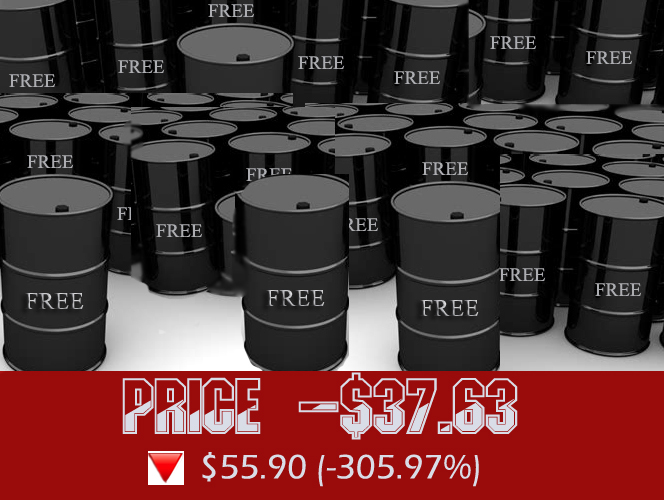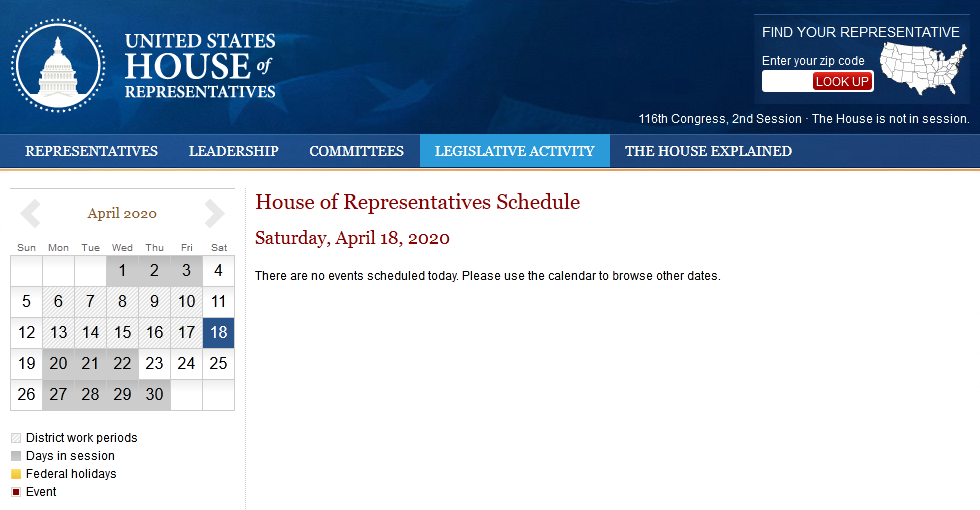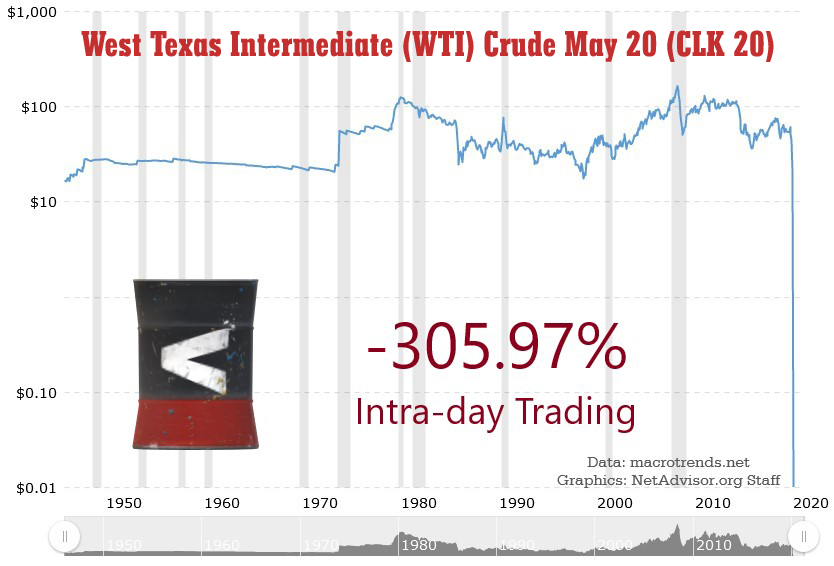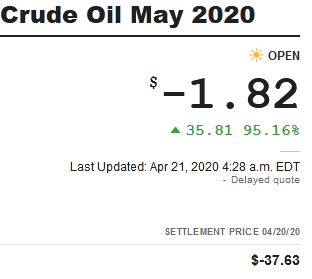April 21, 2020, 7:41 AM EST.
Updated 07:49 AM EST.

written by Net Advisor™
MANHATTAN, New York. Oil Prices Crashed! A highly unusual sell-off of the May 2020 (NYMEX) Futures Contract, sent oil prices plunging to the lowest level in world history. In fact, oil prices were cheaper on April 20, 2020, than they were when oil was first discovered.
Prices stayed below zero and continued to plunge in the negative 305% range for an extended time. This was plenty of time to make the most thought-provoking trading decisions.
With oil at -$37.63 (for example); this means for every oil contract purchased; one would receive a 1,000 barrels of oil for FREE – plus they would pay you USD $37.63 cash per contract. I believe this works out to be $37,630 per contract (current oil price x 1,000 barrels). FYI: There are approximately 42 gallons of oil per barrel; so times 1,000 barrels, that’s a lot of oil.
Normally these contracts settle (pay) in cash, but you can take physical delivery of the commodity.
Not all Speculation.
Sure there are speculators in everything, but the general intent for oil contacts is so producers can lock in acceptable prices for their oil produced or hedge against future prices. The speculators, traders, institutions, brokers, etc., actually provide daily liquidity so people can buy and sell (normally) easily and quickly.
Tried to Buy.
As a former professional trader, hedge fund manager/ licensed advisor, and among other things; the time one can make a fortune is when there is massive panic (up or down), dramatic price disparity, and or confusion (impacts pricing) in the markets. As a trader, price volatility is your friend. There are also ways to mitigate volatility as I discussed here.
So, I actually attempted to buy the said May contract at the above time and rough price, but had zero luck getting the broker-dealer to answer their ***** phone. Their trading system also just did not function correctly. Maybe their system didn’t understand negative prices?
Side bar: When working in this industry 60-80+ hours a week, I had a very pricey, sophisticated system to compete and watch the institutions trade in real time. It was intensely demanding, but it was a lot of fun. I’ve taken the long-term investing approach and moved to other unique opportunities.
Here we had negative oil prices. Usually prices can’t go below zero. If a stock hits zero it’s done. Typically a stock is finished (technically worthless) before it hits zero such as during bankruptcy. When the bankruptcy is approved by the bankruptcy court, the equity in the stock is wiped out to zero.
Commodities (not commodity companies, but the underline commodity) is tangible, and has theoretical value: The steel oil barrow itself can be melted down and sold. The oil can last virtually forever and contents sold at a later date when prices are attractive.
NYMEX currently trades about 1.2 Million contracts a day, so I would pretty much be the market as I wanted to buy one million contracts.
Now it seemed farfetched to do this, but if you don’t try, you’ll never know. Plus, when ever has one seen negative commodity prices?
Can you imagine going to the mall or a new car dealer, picking out what you wanted, and they would pay you to take it away? That was the trading in oil on April 20, 2020. Our math was off earlier, but recalculating now:
A million contracts x 1,000 barrels of oil is equivalent to one billion barrels of oil. To acquire a million contracts, I would need greater access to the market like I used to.
Buying a million May 20 contracts at the time (graphic above)(or however many contracts I could buy), would have paid me $37,630,000 (yes, over $37 Million in cash, less commission/fees) plus, —- oh yea, a billion barrels of oil if I took delivery. Maybe I’d buy up a chunk of desert (no population), put a fence around it, and deliver all the oil there?
While attempting all this, I was trying to broadcast (tweet) and let people know what was going on.
Tried to FYI: POTUS on Cheap Oil.
I did Tweet several times, in real time to try and catch someone who expressed interest in filling up the U.S. strategic oil reserves – and who has the means to do something about it. He was probably busy (already buying oil)?
#OilPrices Experienced a Technical Crash Curr -40% to ~$11 bbl. – The Biggest Drop in #History.#WTI (NYM) Apr Contract -83%; May Contract -82%https://t.co/39qmazwREE@realDonaldTrump 'filler up'
— NetAdvisor.org® (@NetAdvisor) April 20, 2020
#BREAKING #CrudeOil
make that -86% $2.48 bbl— NetAdvisor.org® (@NetAdvisor) April 20, 2020
#BREAKING: *********************************
Oil Prices Crash -99% in one day (still trading)
Curr $0.17 cent bblBUY IT ALLhttps://t.co/N4hLR4hFZe
— NetAdvisor.org® (@NetAdvisor) April 20, 2020
Why Did Oil Prices Crash?
We don’t know yet, and there should be an investigation by the CME Group, parent of NYMEX, and the SEC.
If I had to guess?
- A highly leveraged (hedge) fund or major institution got hit with margin calls, no buyers in the market, and prices dropped, dropped, and dropped. If this was a fund holding long–leveraged May oil contracts, it probably went under and collapsed.
- Another possibility could be that some institutional trader hit the wrong button, “fat finger” and sold a massive (incorrect) number of contracts accidentally.
Oil prices have been under pressure as Saudi Arabia and Russia have been over producing to drive prices down. We’d argue the motive is to kill off U.S. oil industries as the U.S. has become oil independent.
Another factor with overproduction is the lack of global demand. With many countries in effective quarantine amid Coronavirus, few are working, thus fewer driving, or manufacturing oil-related products.
On and off-shore storage tanks are already full of oil reserves. There are oil transport ships anchored in the ocean full of oil, waiting for oil prices to go up so they can deliver at a profit. Not even China is doing much buying of oil.
Original Sources of the Oil Problem.
This all started with the Saudi and Russian price war began impacting global oil markets after the two countries could not come to an agreement on their oil production at the G-20 Summit in Riyadh, Saudi Arabia.
Russian Energy Minister Alexander Novak said oil production talks failed to come to terms between OPEC and Russia on March 6, 2020. OPEC wanted to cut oil output by 1.5 million barrels per day to keep prices higher amid global slowdown.
Russia did not want to cut oil production. So the Saudi oil ministers reversed course and increased production, to drive prices lower to hurt Russia (which also hurts other oil producers such as the USA).
“Saudi Arabia said it would lower prices and increase production even as demand for oil has weakened.”
— Market Watch, March 9, 2020.
Under pressure from the Trump Administration, President Trump managed to get Saudi Arabia and Russia to cut the excess production of oil that was hurting global and U.S. oil markets. Then Mexico weighed in, and threatened to keep producing. Trump managed to get 23 countries to cut oil production now. Congress had been on spring paid vacation during much of this time.


While much of Congress is on vacation, rapidly moving markets are already subject to high volatility due to Covid-19 economic slowdown. With the deceased demand for oil, this must have put a squeeze on some major player that fully unloaded (unwound) their position on April 20th.

Reminder of the Good News!
Just a reminder that low oil prices mean consumers will pay a lot less for gasoline. Probably not free, but a lot less in the coming weeks. Truckers will pay less for diesel which influences the price of food and retail goods.
The bad news is the low oil prices are more than likely to severely impact U.S. (and foreign) oil producers, drillers and independent drillers. We could easily see a number of smaller U.S. producers risk going out of business, which again is what we think the Saudi’s (OPEC) and Russians really want. Once eliminate U.S. competition, they could raise prices to whatever they want.
It would be vital to American interests to help keep the U.S. oil industry, especially smaller and mid-size companies who are successful producers. That way the U.S. does not have go back and rely on foreign imported oil again from countries who are less favorable to U.S. interests.
WTI: Overnight Trading.

I’d expect more volatility for now.
NetAdvisor™ is a former nine-time state, FINRA licensed, 401(k) and retirement planning specialist, experienced in hedge fund management, and a financial and risk management consultant. Read more bio.
Please keep in mind that views and opinions can change as information change, and such may be without notice. Disclaimer.
Graphics copyright by their respective owners.
Original article content, Copyright © 2020 NetAdvisor.org® All Rights Reserved.
NetAdvisor.org® is a non-profit organization providing public education and analysis primarily on the U.S. financial markets, personal finance and analysis with a transparent look into U.S. public policy. We also perform and report on financial investigations to help protect the public interest. Read More.

